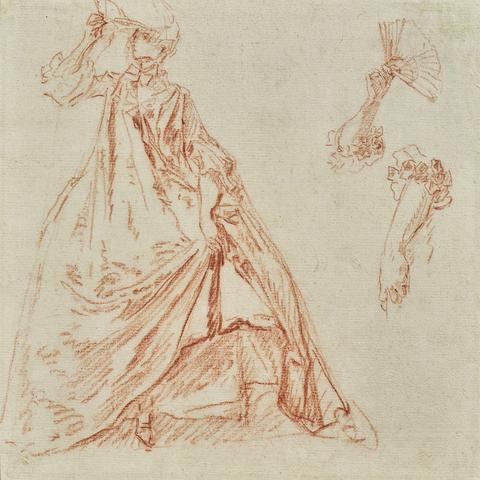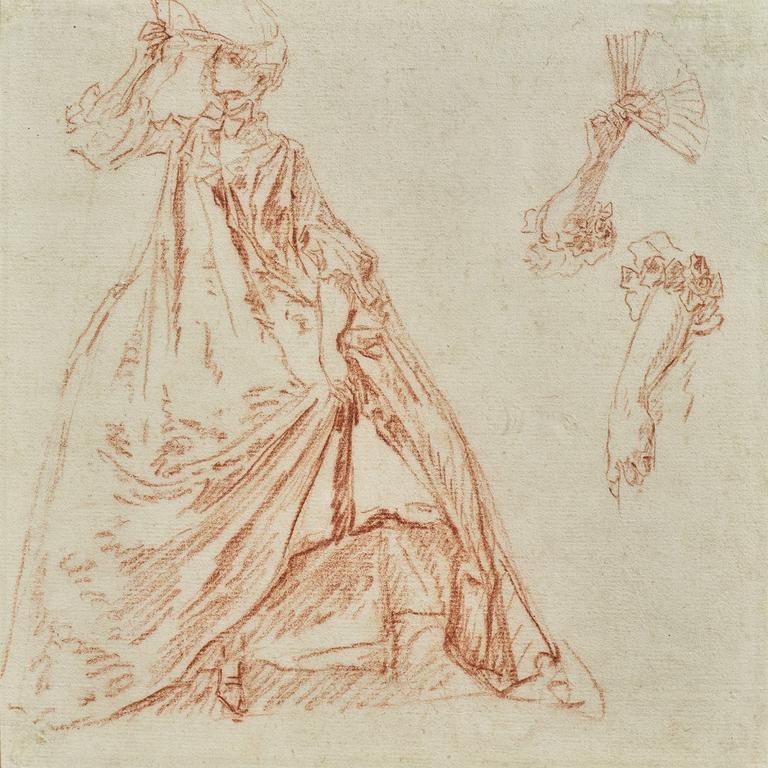
Elégante tenant un éventail et deux études de main
Nicolas Lancret (1690 Paris - 1743 Paris)
1728
Sanguine sur papier ; 18 x 17,9 cm
Provenance :
Paris, Galerie Prouté ; Paris, collection Diane de Pracomtal (Madame Bernard Destremau) ; Paris, Artcurial, 9 juin 2021.
Nicolas Lancret, de six ans plus jeune que Watteau, fut comme lui l'élève de Claude Gillot et l'un des pionniers en France de la peinture de genre et particulièrement des fêtes galantes, si typique de l'art du 18ème siècle et de la « douceur de vivre » dont Talleyrand déplorerait, un siècle plus tard, la perte. Plus réaliste et sensuel, moins rêveur que Watteau dont il s'inspira d'abord, apprécié des cours de Versailles comme de Potsdam, son décès prématuré en 1743 marqua la fin d'un genre qui ne revivra vraiment, dans un style nouveau, qu'avec Fragonard.
Son biographe Ballot de Sovot le décrit dessinant « sur le vif » : « Il ne voyait que des modèles dans les promenades ; et il lui arrivait souvent de quitter ses amis et d'aller dans un point de vue dessiner l'ensemble de tel groupe ou de telle figure qui lui avait plu. » (Éloge de Monsieur Lancret, peintre du roi, 1743). La technique de ce dessin est typique de l'artiste dans sa maturité : la sanguine appliquée vivement mais avec mesure, tantôt large et légère, tantôt précise et plus appuyée.
Difficile ici de dire s'il a croisé cette élégante dans un parc, ou si elle a posé dans l'atelier. On la retrouve, en tout cas, trait pour trait, parée de rose et de jaune, dans un des plus séduisants tableaux de Lancret, Éloge d'une statue de marbre (Rome, Galleria Nazionale Barberini) connu aujourd'hui sous le titre maladroit Le Persan et la statue (The Persian and the statue) et datable de 1728.
En 1737, le critique Cousin de Contamine la décrit ainsi : « A côté du Persan est une française jeune et gracieuse. Sa tête est levée et tournée vers la statue qu'elle regarde avec autant de satisfaction, mais avec moins d'étonnement. Elle tient de la main droite son éventail ouvert qu'elle met au devant de ses yeux pour les garantir du trop de lumière. Et de l'autre main elle relève sa jupe de taffetas pour laisser voir son jupon. » (Descriptions raisonnées de quelques ouvrages de peinture et de sculpture, 1737).
Elle laisse voir d'ailleurs un peu plus, dans le mouvement dialectique des deux mains : l'une qui protège le visage, l'autre qui découvre le pied, une part de l'anatomie féminine qu'ignorait le siècle de Louis XIV mais qui dès la Régence pointe sous les robes amples et dont la valeur érotique ne fera qu'augmenter ensuite. On pense bien sûr à La Jarretière de Jean-François de Troy (New-York, Metropolitain Museum), antérieur de quatre ans à L’Éloge d'une statue de marbre et que Lancret devait connaître.
Quant à cette statue, c'est Le Soldat bandant son arc (Paris, Musée du Louvre) de Jacques Bousseau (1681-1740). Ce dernier en avait offert un « modèle » à Lancret qui avait ensuite composé, pour le lui offrir à son tour, le tableau.
Ce croquis d'une admiratrice de l'art – « Cette femme peut signifier qu'il est encore de vrais connoisseurs parmi nous », poursuit le commentateur – nous pouvons l'admirer à notre tour comme un reflet de la curiosité, de la civilité, de la sensualité du siècle des Lumières.
